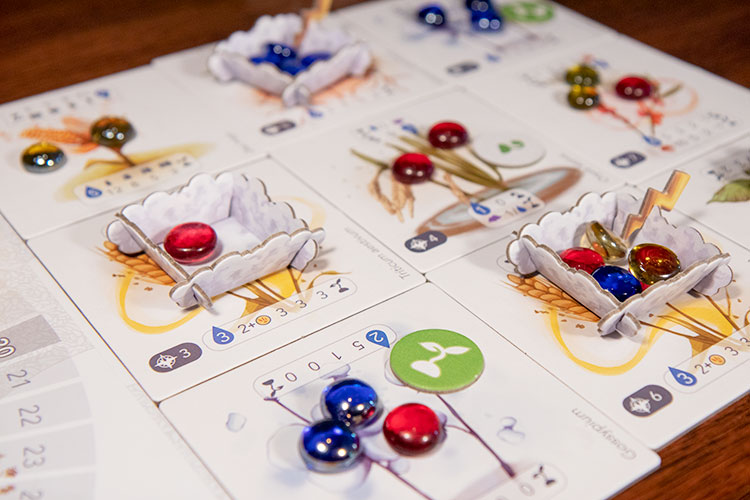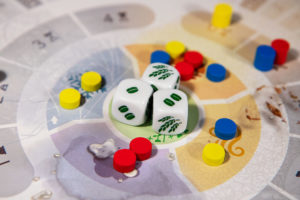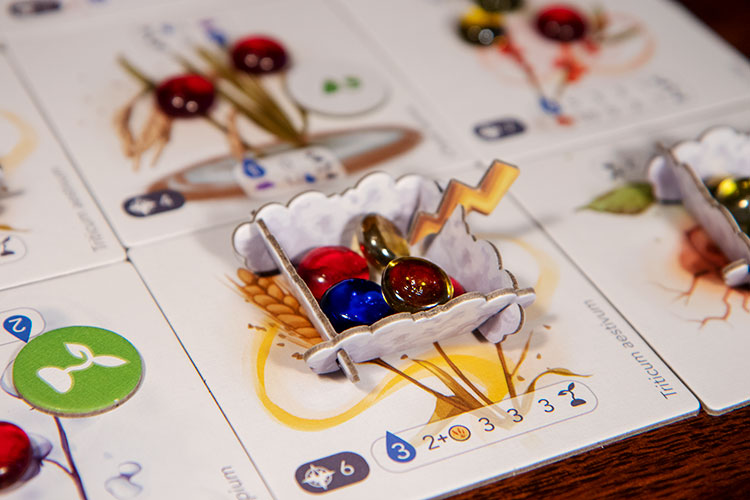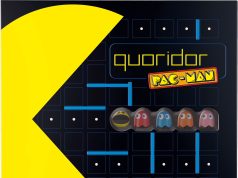 Publisher Mighty Boards has really been coming out with a unique lineup of board games. First was Posthuman, their post apocalyptic survival game. Then came Vengeance, the action movie revenge game. And now we have Petrichor, a game about controlling clouds over fields of crops. I’ll say this about Might Boards, they know how to take a underused theme and run with it.
Publisher Mighty Boards has really been coming out with a unique lineup of board games. First was Posthuman, their post apocalyptic survival game. Then came Vengeance, the action movie revenge game. And now we have Petrichor, a game about controlling clouds over fields of crops. I’ll say this about Might Boards, they know how to take a underused theme and run with it.
Petrichor is an area control game for 2-4 players that takes about 30-60 minutes to play. The game plays best with 3 players.
Gameplay Overview:
The goal in Petrichor is, of course, to score the most points. The game is played over 4 or 6 rounds, chosen at the start of the game.
Each round is broken up into 4 phases:
1. Action:
In turn order, each player plays a card from their hand and takes the associated action. Options include starting new clouds with one of your raindrop tokens, adding more drops to a cloud, moving a cloud, or raining drops onto a field.
After their action, a player must place a voting token on a weather effect, or tick down a harvest die on number (earning a victory point). Then the next player takes their turn and so on until all players have passed.

2. Weather
There are four weather spaces (that correspond to the matching cards). Which ever two spaces have the most votes are resolved. These range from increasing water drops in clouds to raining all the drops onto the fields below them. The player that has the most voting tokens on each of the two weather spaces that were resolved gets to move up one space on the weather voting track (which earns bonus VPs at the end of the game).
Finally, each field is checked for growth. If the field has enough water drops to meet its sprouting minimum, a growth token is placed on it.
3. Harvest
If all three harvest dice are showing the harvest icon, a harvest occurs. Each field with a growth token is scored according to their rules. The points will vary, but usually area majority is the key here.
4. Clean up phase
Players draw 7 new cards and the harvest dice are rerolled if a harvest occurred. Then a new round begins.

Game Experience:
While I only touched on the nature of the actions above, one thing I liked about Petrichor is how well they tied the mechanics to the theme. If you take a wind action, it blows a cloud across a field. A rain action? Rains drops onto the field below. I always prefer when a game is tied to its theme and Petrichor was spot on in this regard.
Overall, I’d call Petrichor about a medium weight game. The rules explanation takes a little bit of time, but after a round or so, everything will make sense. Petrichor is really just an area control game where you are telegraphing your moves. Whether that’s good or bad is really up to what you like in your area control games. This isn’t the kind of game where you will sneakily grab a field from someone. If you want to control a field, it’s going to take multiple turns to get everything lined up.

The upside is that for players who love strategic planning, you will be right at home here. Sometimes you will not only need to look multiple turns ahead, but even sometimes a round or two ahead as a couple of fields require multiple rounds of preparation to score their fullest. Of course, Petrichor can have a bit of take that as players can also disrupt your plans should they chose to do so.
Petrichor can be played in either four rounds or six, depending on the game length desired. We almost always played in four rounds, which felt right. To be honest, the slow paced nature of the gameplay had us ready for the final scoring after four rounds, so I think only the most die hard of fans are going to want to play this one for six rounds.
When it comes to player scaling, I think the sweet spot for Petrichor is at 3 players. With two players, as with most area control games, it can devolve into each player just kind of doing their own thing with little competition over spaces. At four players, it gets a little chaotic and makes planning harder (although there is much more interaction). Three really felt about right with the play time versus control. There is also solo play in the box if that’s your thing.
Finally, I must say, as is the trend with their games, Mighty Boards did a great job with the components in Petrichor. The art is beautiful and there are even little 3D clouds to hold your rain drops. Everything feels light and airy, which is a perfect call back to the theme of the game.

Final Thoughts:
Petrichor is a really good area control game that uses its theme well. While the actual field scoring doesn’t feel that revolutionary, how you get there does feel pretty unique. I think Petrichor will appeal to gamers who like a “slow burn” in their games, where it can take multiple turns to build up to something. While there is some “take that” in the game, it really is a minimal aspect. Petrichor looks great and is fun to play, it’s worth checking out for fans of the area control genre.
Final Score: 3.5 Stars – A solid area control game with some great production values that uses its unique theme quite well.
 Hits:
Hits:
• Great use of the theme
• Can be highly interactive
• Clever mechanics for establishing area control
Misses:
• 3 players is really the best way to play
• Could use a bit more variety in the field tiles






















